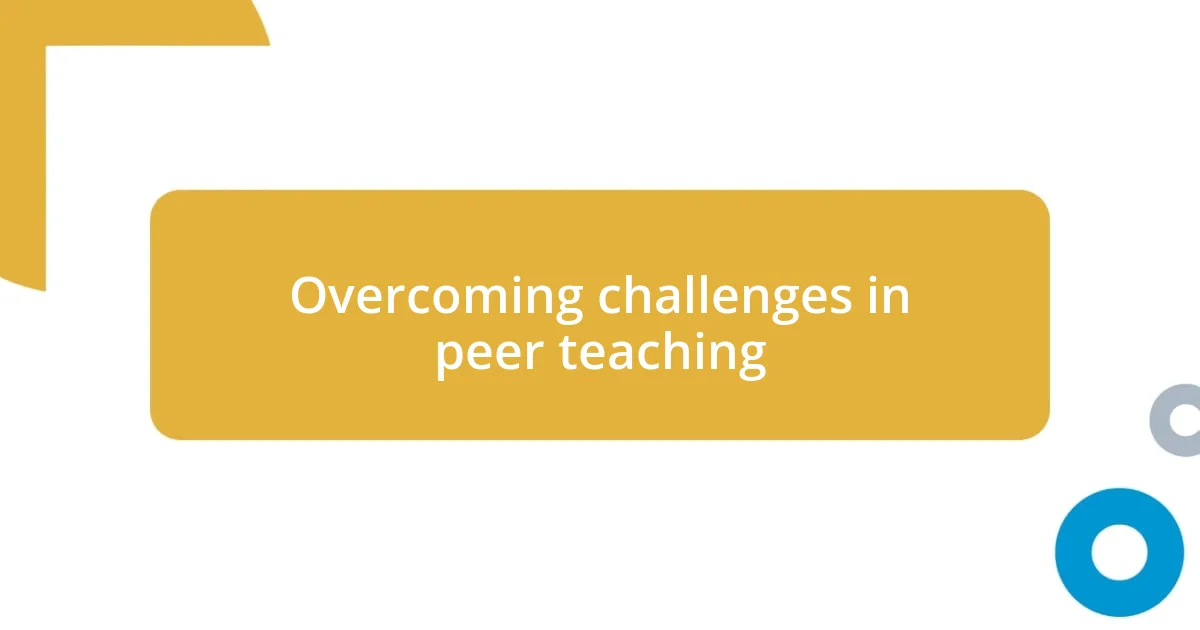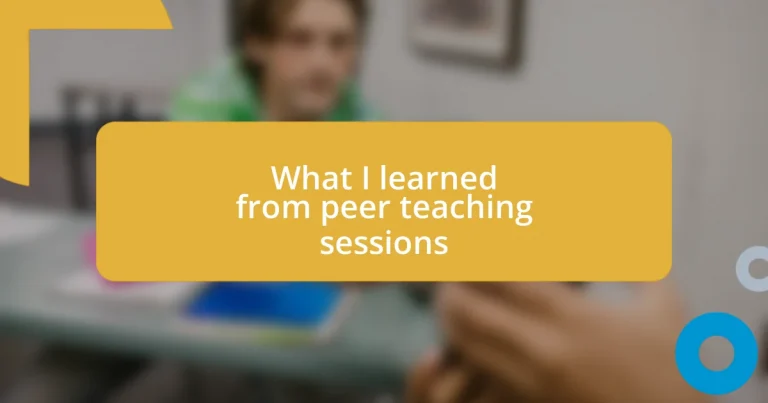Key takeaways:
- Peer teaching enhances understanding, builds confidence, and fosters critical thinking through collaborative learning experiences.
- Effective strategies include promoting active engagement, incorporating diverse learning styles, and encouraging inclusive participation to address various challenges.
- Gathering and utilizing feedback is essential for improvement, as it strengthens the learning community and enhances teaching methods when integrated into the curriculum.

Understanding peer teaching benefits
Peer teaching offers a unique opportunity for students to learn from one another, creating an environment where collaboration thrives. I remember the first time I facilitated a session; there was a spark in the room as my peers asked questions and we all shared insights. Can you recall a moment when you understood a concept better after explaining it to someone else? That’s the magic of peer teaching—it reinforces knowledge while building confidence.
Another remarkable benefit is the development of critical thinking skills. When I peer-taught complex topics, I found myself looking at the material from different angles, and that really challenges your understanding. Have you ever had an idea transformed through discussion? It’s like peeling back layers, revealing deeper connections and nuances that might otherwise go unnoticed.
Additionally, the social aspect cannot be overlooked. In my experiences, the friendships I forged during these sessions enhanced the learning atmosphere, making difficult subjects feel approachable. Isn’t it fascinating how learning can be a shared journey? When we support each other, we create a community where everyone feels valued and empowered to grow academically and personally.

Effective strategies for peer teaching
When it comes to effective strategies for peer teaching, preparation is key. I remember one session where I took the time to outline clear objectives beforehand. This made all the difference in keeping my peers engaged and focused. Creating a structured outline not only organized my thoughts but also helped my classmates understand the topic more easily.
Here are some strategies I found to be particularly effective:
- Active Engagement: Encourage questions throughout the session; it fosters interaction and deepens understanding.
- Variety of Learning Styles: Incorporate visual aids, discussions, and hands-on activities to cater to different preferences.
- Peer Feedback: After a teaching session, I often sought feedback from my peers, which helped me refine my approach in future sessions.
- Positive Reinforcement: Celebrating small wins and recognizing each other’s progress boosts motivation and confidence in the group.
Emphasizing collaboration rather than competition created a more relaxed environment, allowing everyone to feel like they could contribute. There was this one time a classmate taught a particularly tough concept using dance moves to illustrate the core ideas. I was surprised at how much easier it was for everyone to grasp the material when it was presented memorably.

Overcoming challenges in peer teaching
Overcoming challenges in peer teaching often requires us to navigate through uncertainties and differing levels of understanding. I vividly remember a session where one of my peers struggled to grasp a key concept. Instead of feeling frustrated, I embraced the challenge and adjusted my explanation, using simpler terms and relatable examples. It was a reminder that patience is paramount; everyone learns at their own pace, and adapting our teaching style can truly make a difference.
I’ve encountered communication barriers during peer teaching too. One time, I partnered with a classmate whose background differed significantly from mine, leading to potential misinterpretations. I focused on establishing a common language, frequently checking for understanding, which ultimately fostered a stronger connection. Have you ever felt a lack of clarity in a discussion? That shared experience showed me that open dialogue can break down walls, creating an environment where learning thrives.
Additionally, there have been times when a quiet student in the group felt overshadowed. I learned the importance of inclusivity in these moments. I made a conscious effort to encourage contributions from everyone, transforming the atmosphere. By valuing diverse perspectives, I found that the quietest voices often shared the most profound insights. Reflecting on these instances, it’s clear that overcoming challenges in peer teaching is less about perfection and more about embracing the journey together.
| Challenge | Solution |
|---|---|
| Diverse Understanding Levels | Adapt teaching methods and use relatable examples |
| Communication Barriers | Establish common language and encourage dialogue |
| Inclusivity Issues | Encourage contributions from all peers, fostering diverse perspectives |

Gathering feedback for improvement
Gathering feedback is a crucial aspect of any peer teaching session. I’ve found that creating a safe space where peers feel comfortable sharing their thoughts can lead to rich and insightful feedback. After one session, I was surprised when a classmate mentioned how my pacing made it challenging for them to follow along. At first, I felt a twinge of defensiveness, but I quickly realized that this was a gift—a chance for me to improve and grow. Have you ever received constructive criticism that shifted your perspective?
In another instance, I encouraged my peers to complete a quick anonymous survey right after a teaching session. Their candid responses highlighted moments I hadn’t considered, such as my use of certain jargon that might have confused some. It was eye-opening! From that day, I made a personal commitment to adapt my vocabulary, making sure it matched the group’s understanding. This aligns with the idea that feedback isn’t about validation but is a stepping stone toward enhancing our skills.
Reflecting on moments of feedback, I began to notice a pattern—the more I openly asked for their thoughts, the stronger our learning community became. I remember one session where a peer expressed how a particular visual aid helped clarify a complex concept. That simple acknowledgment inspired me to explore different teaching tools in future sessions. It’s fascinating how encouraging a culture of feedback not only enhances individual teaching styles but also fosters a collaborative environment where everyone can thrive.

Integrating peer teaching into curriculum
Integrating peer teaching into the curriculum can truly transform the learning experience. I remember the thrill of designing a lesson plan that included group teaching activities. The excitement that filled the room when peers taught each other was contagious! It made me realize that learning goes beyond traditional methods—when students take the reins, they engage with the material in a way that’s both meaningful and memorable.
In another instance, I found value in creating peer-teaching pairs based on varied skill levels. Once, I partnered a struggling student with someone who excelled. Watching them collaborate was enlightening; their unique perspectives brought the topic to life! This experience solidified my belief that integration of peer teaching nurtures what we often overlook in education: the sense of community and shared responsibility for learning. Who wouldn’t want to foster a classroom atmosphere where everyone contributes to each other’s success?
Moreover, I learned that setting specific goals for peer teaching sessions can enhance their effectiveness. During a project, I encouraged my peers to define what they wanted to learn from each other before diving into discussions. This little shift made such a difference! Everyone came to the table with intention, and discussions became substantially richer. It’s as if we unlocked a new level of understanding—don’t you think that clarity in purpose can elevate any collaborative effort?












